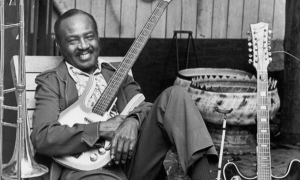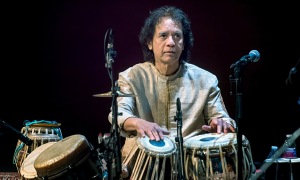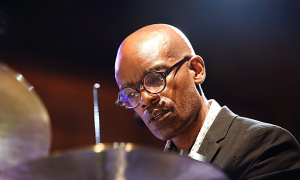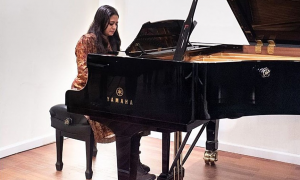Home » Jazz Articles » Under the Radar » A Different Drummer, Part 3: Pino Basile & Mizuki Wildenhahn
A Different Drummer, Part 3: Pino Basile & Mizuki Wildenhahn

Courtesy Antonio Facai
The challenge is to make a cultural evolution that is symbolically very important to me: to try to restore to my land, as a craftsman of sound, a dignity and awareness…
—Pino Basile
The Swish Knocker, And More
Early on in his career, the late Milford Graves abandoned the snare drum, substituting the resonance of the toms for the snare parts. He believed music of the drum reverberated from within the drummer and the listener without the need for extraneous instrumentation. Tyshawn Sorey's approach to music speaks to contempt for classification. His kit is often a vast collection of tuned and untuned percussion; cymbals, gongs, bells, shakers, and paraphernalia that almost obscure the set's conventional components yet coalesce into an articulate system. The tools of the percussion trade are the least universal in music.The composer Charles Ives wrote, "The possibilities of percussion sounds...have never been fully realized." This enormous family of pitched and unpitched percussion instruments are struck, scraped, rubbed, brushed, shaken, stepped on, and slapped. From everyday items like a plastic bucket or garbage can to the unconventional flexatone and the pogo cello, percussion instruments are ubiquitous. Juba, hambone, tap dance, and stepping didn't become anachronistic post-slavery; they live on in the contemporary approaches to percussion. The standard kit may be the norm, but it's not implausible to find a drummer augmenting with a rototom, a cluster of octobans, a wooden fish, or a swish knocker. In Part 3 of A Different Drummer, we talk to two percussionists who perform outside the mainstream and in different ways.
Percussionists, Swimming Against the Tide
Pino Basile, best known as the multi-percussionist in Giuseppe Doronzo's AVA Trio, moved on from playing the conventional drum set in his youth. The Zürich, Switzerland native holds a degree in Percussion Instruments and has performed in jazz, classical, dance, and contemporary circus theatre. A researcher and teacher, his mission is to bring exposure to what he calls the "unsophisticated" percussion devices. His "cupaphon" was a personal evolution from the family of friction drums. The putipù, a friction drum from Southern Italy, consists of a sound box topped by a membrane and a bamboo cane attached at the center. The instrument is played by manipulating the cane by hand, causing the membrane to vibrate. In some cases, the friction is obtained by spinning the drum around a pivot. The putipù has several common names: caccavella, pignato, cupellone, bufù, cupa-cupa and others. Sound boxes are constructed of clay or wood; the membranes are made from skins or cloth.Dance and drumming have always been intrinsically linked in West African, Indian, and Afro-Cuban culture. German artist Mizuki Wildenhahn studied flamenco in Madrid, Spain, before developing her percussive dance style, collaborating with musicians in jazz, rock, and free improvisation. She performed at the live premiere of pianist Aki Takase, and reed player Silke Eberhard's Ornette Coleman Anthology (Intakt Records, 2007). She has worked frequently with Satoko Fujii and was featured in the pianist's Amu quartet on Weave (Libra Records, 2018) with Natsuki Tamura and Takashi Itani.
All About Jazz: Could you tell me about where you grew up and what were your earliest musical influences?
Pino Basile: I was born and raised in Zürich in the first years of my life in a family of craftsmen emigrants last of 4 children, always traveling between Italy and Switzerland until the age of 14 and then permanently remain in Italy (in Altamura, where I currently live). This forced me to face two very different cultural worlds, imagine the difference between the rich and industrious Zürich and southern Italy in the seventies, without ever being able to fit in well anywhere. I was like a Swiss in Italy and an Italian in Switzerland!
The first musical listeners were the audiotapes of my older brothers with Bob Dylan, Fabrizio De Andrè, blues music, etc.
As a child, I wanted to be a policeman, and my brother played blues on the guitar, then my brother became a policeman, and I became a musician without ever being able to play the guitar.
Mizuki Wildenhahn: I was born and grew up in Hamburg, Germany. My parents were great music lovers, my father, a film director, made documentaries about Jimmy Smith and John Cage/Merce Cunningham in 1966/67. My parents' record collection included very diverse styles: Japanese and European folklore (folk?) music, jazz, blues, pop. As far as I can remember, music was very present at home, and we children were encouraged to sing, play and dance along to the music played.
AAJ: Pino, what was the first instrument you studied, and when were you introduced to percussion?
PB: As a boy I started playing congas and bongos as a self-taught person not knowing what I was doing because in the eighties there were still no Afro-Cuban music schools in my town, but undergoing an incredible charm, almost a call from the forest.
AAJ: Mizuki, did you study a musical instrument as well as dance?
MW: I think I would have liked to be a musician because I enjoyed music so deeply, I always felt that creating music must be the most wonderful experience. But somehow, the instrument and learning to use it would stand between me and the expression I sought, which did not happen when I simply moved and danced to music. As a child, my parents sent me to violin lessons, but I never reached the level to enjoy playing it. The same occurred when I tried learning the flamenco guitar, which I started the same time I started taking flamenco dance classes, but soon gave up.
Discovering flamenco dance was finally the solution to my dilemma: since you create sounds with your feet while dancing, accompanying, accentuating the music, and also soloing, you actually are a musician and are yourself involved in creating the music that you dance. And the floor as an instrument did not seem to have the daunting effect on me that "conventional" instruments had.
AAJ: Mizuki, you studied flamenco dance in Madrid, and that style is evident in the videos from Amu: Weave. How did your style move toward the more rhythmic method of percussion?
MW: I moved away from flamenco because I noticed I was always unconsciously copying a certain image I seemed to have in mind, never quite making it 100% my own, which is fine and enjoyable in class, but very frustrating when you create and perform.
I once saw an American comedian who lives and works in Germany perform in German. She was great because her American accent and grammar errors actually made her performance better; she could use what would have been her disadvantages and actually turn them into assets. Since I did not grow up with flamenco music and dance, it was not my native expression, but unlike that comedian I was not able to create my own style within flamenco.
So I started collaborating with musicians from other genres to see what I could do within the framework of other musical styles. That is when I went on various extended stays to New York because I also wanted to see live concerts of diverse styles. I do not seem to turn to dancers to find new ideas, but rather musicians, to see what possibilities there are for me, and to learn from their approach and translate it to my needs, since music is originally the impulse that makes me dance. (Though I watched some excellent tap dancers, their technique, and use of percussion while I was in NY.)
I would go to venues like the Knitting Factory and the Tonic a lot, absorbing all the music I could and watching the musicians. For a while, I experimented with different surfaces to be able to create a greater diversity of sounds but ended up deciding against it for the time being. And I would rent a studio and invite musicians for sessions.
In the end it was especially free improvised music that seemed a natural fit for me, enjoying being guided by spontaneous intuition and reaction, to use sounds also in a melodious, not strictly rhythmic way, or using beats and stomps as expression rather than solely as part of a rhythmical pattern.
To me in Percussive Dance at least part of the movements are used to create sounds. The feet are used to great extent to play the percussion instrument, mostly the surface you stand on. This leaves the rest of the body free for simultaneous expression through movements or create more sounds by slapping, clapping etc. While producing the sound with the feet the body is being moved (rhythmically in the traditional forms), which in itself is dance.
AAJ: Mizuki, can you make a comparison between Percussive Dance and traditional percussion performance?
MW: I think the main difference lies in the use of visual expression: watching a musician perform of course you also receive visual information by seeing her/his body move. These movements may be intentional or unintentional, but they are received by the audience, more or less consciously, as part of the musician's expression, which is why one enjoys videos of concerts, not just CDs.
But a percussive dancer uses movements specifically and intentionally. So the audience pays attention to the visual aspects of the performance. The percussive dancer can choose between the extremes of nearly no (expressive) movements: while concentrating on the percussive part of the performance, reducing the movements to be merely the necessary ones to create the sounds, as a musician would; or to use silent movements, the expression solely visual. And of course, mix visual and acoustic expression, varying the degree of emphasis on one or the other.
Instead of adding visual to the acoustic expression the percussionist normally uses a wider scope and sophistication of sounds and instruments than the dancer, since the focus is on the sound.
Another difference between a percussionist and a percussive dancer is the role they are expected to take on in a group setting: whereas I would assume the percussionist switches back and forth between soloing and accompanying, the percussive dancer probably more often than not is expected to be the soloist or front person. When I work with musicians for the first time they often do not consider the possibility of having me accompany them until I actually do so.
AAJ: Pino, what is it about percussion that appeals to you?
PB: I really have no idea; I always have the physical need to play them. Perhaps because with percussion, I feel free to play anything, being able to transform any object or material into a musical instrument.
Then I realized that the real instrument is actually us; what we play are only the software and the audio interface (forgive me the digital metaphor to explain a totally analogue fact).
AAJ: Pino, as an instructor, it's part of your mission to teach people about less familiar percussion instruments such as frame drums and friction drums. Frame drums have a presence on every continent, but friction drums are less well-known. Can you talk about friction drums; how are they used, and by whom? And why are you interested in this category of percussion?
PB: Yes, in fact the right word is: mission. But I need to explain it.
Since I stayed in the south, where I decided to live and raise my family, I have made a cultural choice of attention to my roots. I understood this as an adult when one day I saw my mother playing the tamburello (the frame drum of southern Italy) in a style that I had never seen before and which I discovered to be the typical rhythm of tarantella of our land, the Plateau of the Murge, an area between the regions of Puglia and Basilicata. Well, I didn't know my mother could play the tamburello, and I didn't even know there was a traditional style in our area to play it. It was a shock.
All my life I went in search of a musical and cultural identity (from Afro-Cuban congas to African instruments, to the Afro-American jazz drum set) passing through the academic studies of the conservatory and the repertoire and sound experimentation of twentieth century percussion, I discovered that mom was playing the tamburello, our tamburello! I have reset.
In the meantime, I gave my mother a brand new tamburello and learned to play first the tarantella style of my country and then everything possible and more just with a tamburello, mine. Then I decided to start all over again by putting the human approach and the culture of sound that I began to seek and found in my land at the center of my musical universe. A culture made of poverty, exploitation and sacrifices, which music has helped to overcome with dignity and creativity, helping people to always survive with joy. The study of some anthropology books helped me to interpret and make some concepts my own. So I have discovered many instruments that we can roughly define [as] "ephemeral." Created for the occasion and in any case not considered real instruments.
The friction drums have been a great discovery for me, I think they are the symbol of our sonic identity, but they have never received any kind of attention from the musicians.
The friction drum, which we call "Cupa cupa" represents transgression, the breaking of routine and normality, in fact in the past it was only played during the carnival period, that says it all. Often played by women of the "lower" classes, it is used to accompany the so-called "canti a cupa cupa" as an alternative to the tamburello.
Curt Sachs believes that until the Middle Ages it was used as an instrument for sexual education towards adolescents, I believe that it was then discriminated against by the Catholic Church because it was considered blasphemous, and that is why it found space during the carnival period, the moment of [the] year in which the ritualization of blasphemy and the breaking of normality are socially necessary as well as tolerated. A very interesting aspect is that friction drums have always been widespread everywhere in Europe (Holland: "foekelpot," Spain: "zambomba," Portugal: "sarronca," etc.), in Africa and South America, almost always with the same function but with different names and construction variants (Brazil: "cuìca," Venezuela: "furruco," Zambia: "puita," etc.). There is no bibliography about it, all I discover is through the travels and encounters with the different cultures that I crossed as a musician. In a painting by Bruegel, a Belgian painter of the 1500s, a friction drum player is represented ("Fight between Carnival and Lent").
The most incredible thing that happens to me is that when around Europe I play my cupa cupe I often meet people, usually not young, who recognize the instrument as their own and always tell me the name by which it is known in their culture. I believe that the cupa cupa is an unexpectedly cosmopolitan instrument: it represents my identity and at the same time many others, it is a true example of globalization.
AAJ: Mizuki, there are Percussive Dance forms from Africa, Appalachia, Ireland, and more. Are tap, clog dancing, step dancing all forms of Percussive Dance, and how do they vary?
I do think they are forms of Percussive Dance, but I am no expert. I am fairly sure though that they vary very much in their expression, the emotion they convey. But even if the upper body is not explicitly used for expression, and the feet are used for stomping/tapping etc., for me it is a dance. I suppose most popular Percussive Dance forms are rhythmical. The footwork emphasizes and accentuates the rhythm. I would even speculate that they started as a silent rhythmical dance and by stomping some beats with more energy little by little developed the acoustic side. But this is pure speculation, I never did any research into this matter.
AAJ: When you perform with jazz and experimental artists, you use tap, stomps, slaps, and other movements. Are you often freely improvising your moves?
MW: In recent years, all of the projects I participate in involve free improvisation to a greater or lesser degree, with more or fewer composed or choreographed parts. And since I use the floor of the venues, I perform at as my main instrument, though sometimes I might cover it with boards, the sounds and the feel of the impact vary greatly, which leads me to use or omit different techniques spontaneously, depending on what sounds and feels right in that instance. And also, depending on the venue, I have more or less space for movements, especially at Jazz clubs. I frequently have as little space as any musician on the stage. Under these circumstances having the freedom to improvise can change a limiting condition into an interesting challenge.
AAJ: Mizuki, Amu: Weave, with Natsuki Tamura, Satoko Fujii appears to be your only non-video recorded music. Is Percussive Dance an art form that doesn't easily translate to an audio format?
I actually recorded with a flamenco guitarist before as a guest on his CD. In flamenco, it is not unusual at all to record the footwork of a dancer.
In the projects I work in nowadays, though, I would say a recording without the visual component lacks at least half of what I would want to express. Especially since I often use the percussive part less as rhythmic, groove-based, or melodic input, but rather as an expression underlining or augmenting a movement. Maybe comparable to experiencing a video of somebody, for example, screaming, where you can also see the facial expression, be it in anger, fear or delight, etc., as opposed to hearing that scream without the image. The result can differ greatly. A singer nevertheless can be recorded perfectly on CD because he or she will channel the entire expression into the voice; they do not need the image.
Unlike percussionists, I think it would be very difficult, to say the least, for me to express myself completely and exclusively through percussion.
AAJ: Pino, you contribute as a composer, teacher, and musician, in the area of "acrobatic arts and the new circus." It sounds like Cirque du Soleil, a combination of Chinese dance, acrobatics, and modernized vaudeville. How did you become interested in this form, and how do you participate in it as a percussionist?
I have been working with the contemporary circus and dance for many years; indeed it is now one of my major activities. I discovered the circus thanks to a collaboration in 2006 as a performer and music consultant for a production of the Brussels high school of circus (E.s.a.c.) together with my friend composer Riccardo Nova under the direction of the Spanish choreographer Roberto Olivan. From that moment, a process began that has not yet stopped collaborating, for some years with the Italian acrodancer and director Francesco Sgrò and with various circus schools in Italy and also in Holland.
For me, it is a place of research and interaction with performative artistic disciplines. Always working in conditions of maximum musical creative freedom. As a musician, I learned a lot from the circus world, and this influenced my way of playing percussion and being on stage, overcoming many physical inhibitions that the academy often leaves. The instrument of the acrobat and the dancer is the body. Relationships are created between physical gesture and sound gesture that originate scores, sometimes structured, sometimes improvised, sometimes solo, and sometimes orchestral. This gives me such different inputs and points of view that greatly enrich my way of playing and thinking about music, even if I don't consider myself a composer at all. But I love the idea of giving sound to a movement.
AAJ: On the 2020 AVA Trio album, Digging the Sand you played the tamburello (tambourine), bendir (a frame drum), and the cupaphon, (a friction drum). Do you play a standard drum kit on occasion?
PB: The standard drum kit is an instrument that I only played in my youth then I started to literally "take apart" the set and with various intermediate steps I arrived at the tamburello and the cupa cupe set that I called Cupaphon. I do not hide however, that the experience of the drums gave me the concept of swing and groove that I always carry with me.
AAJ: Pino, the cupaphon is a fascinating instrument you developed yourself. What is the story behind that?
PB: Cupaphon was a personal evolution of the folk version of the cupa cupa, since it makes no sense for me to play the cupa cupa as in the folk cliché, I concentrated all my efforts in trying to update and revive an instrument from history and project it into [the] future. It is the mission I mentioned above.
With cupaphon the traditional instrument becomes a contemporary percussion. Specifically, I transformed an instrument with an indeterminate sound, characteristic for its sound very close to the sound of an animal, into one with a determined and rhythmically more defined and versatile sound by assembling a set made of several friction drums.
With the cupaphon I improvise, write and perform compositions by contemporary music authors who have begun to take an interest in and write for this "new" instrument, I cite the case of Admir Shkurtaj an Albanian composer who paid me a lot of attention.
The challenge is to make a cultural evolution that is symbolically very important to me: to try to restore to my land, as a craftsman of sound, a dignity and awareness that have often been obscured by a widespread complex of cultural inferiority and isolation.
Selected Discography
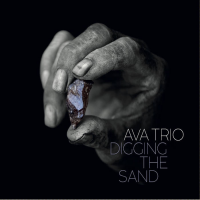 AVA Trio: Digging the Sand (Marocco Music, 2019)
AVA Trio: Digging the Sand (Marocco Music, 2019) In 2017 the AVA Trio released their debut album Music from an Imaginary Land (Tritone Records), earning spots on several year-end polls. That inaugural release was a unique amalgamation of ethnic influences and free improvisation. With the release of Digging the Sand, the group continues to mine the imagination and avoid cliché-riddled and well-worn paths.
Amsterdam-based baritone saxophonist Giuseppe Doronzo has a background that includes jazz improvisation, classical and non-western music. He has composed for choreographer Cora Bos-Kroese and performed with saxophonists Joe Lovano, Chris Potter, trombonist Robin Eubanks and trumpeters Paolo Fresu, Ralph Alessi and Taylor Ho Bynum, Vince Mendoza, Han Bennink, and many other notable artists. The native of Barletta, Italy, played with American saxophonist and clarinetist Michael Moore - Clarinet's Bigtet, a group that included keyboardist Kaja Draksler. Soon after, he formed the experimental quartet Falga, and—in 2015—his AVA Trio.
Pino Basile is a new addition to the AVA Trio, and the percussionist brings an unusual array of resonances to the group, and like Doronzo, has an enormous range of musical experiences. An academic, he shares his knowledge of Mediterranean region percussion wherever the opportunity presents itself. On Digging the Sand Basile plays the tamburello, bedir and the cupaphon, a tuned friction drum with an astounding range of sounds. The latter is found in the music of four continents; made from a variety of materials, it is—in Basile's hands—a proxy for strings, reeds, and less identifiable sounds.
Turkey's Esat Ekincioglu has played bass since his pre-teen years and has worked across genres as diverse as heavy metal rock and Turkish pop music. Relocating to the Netherlands in 2011, he studied at the Prince Claus Conservatorium in Groningen and won a major European talent competition as a soloist. A prolific performer, he has toured throughout Europe, the Middle East, and the US. Confirming his credentials for this non-conformist group, he also records and performs with the improvised jazz-punk-psychedelic quartet Kuhn Fu.
This is a carefully studied collection, enhanced by collective and individual improvisations. Doronzo wrote six of the eight pieces with Ekincioglu contributing "Tosun" and "Kacti." The music is as hypnotic as it is intricate. The baritone oozes heat and edginess simultaneously on "Cala di Turchi," a blend of Mediterranean and western styles nicely augmented by the Basile's bedir and a deep, woody bass solo. Inspired by the local elements of air and water, "Vento di Ponente," is a piece with rudiments of Balkin dance interwoven with AVA's idiosyncratic instrumentation. Doronzo's title track suggests something darker as it creeps along with subdued effects that wrap up with the halting but disconcertingly soulful baritone. He takes up the Egyptian double-reed mizmār for the middle section of "Distanze," a piece whose pace modulates from languid to break-neck speed, and back again.
Cala Dei Turchi; Espero; Fadiouth; Digging the Sand; Tosun Kacti; Ayi Havasi; Anamoni; Distanze.
Giuseppe Doronzo: baritone saxophone, mizmar (8); Esat Ekincioglu: double bass, prepared double bass (4); Pino Basile: percussions, cupaphon (4).
 Amu Weave (Libra Records, 2018)
Amu Weave (Libra Records, 2018) The year-long Satoko Fujii sixtieth-birthday project entered its final quarter in autumn 2018 with the stellar Weave. In a year of unusual releases, her newly assembled quartet—Amu—represents Fujii at her most unconventional yet accessible. The group includes Fujii's husband and frequent partner Natsuki Tamura on trumpet and percussion, drummer and percussionist Takashi Itani and percussive dancer Mizuki Wildenhahn. The mixed-media release consists of an audio disc and a DVD that features six of the seven audio pieces; the two components do not represent a zero-sum game for the listener/viewer but certainly enhance the overall experience.
Itani has a history with Fujii, having been part of one of her namesake quartets and the Tobira quartet, as well as her New Trio on Spring Storm (Libra Records, 2013). Wildenhahn's relationship with Fujii dates back to 2008 when she began incorporating dance into the pianist's live performances. She was also part of the Fujii quartet known as Dos Dos, a group that she features on the Weave line up (minus Faín Dueñas as the drummer and percussionist).
Wildenhahn's movements, and the scraping and rustling of Tamura's trumpet, set the stage for the cinematic sweep of Fujii's piano as the seventeen-minute "Megosona" opens the set. Building in force, Itani exercises restraint in keeping the drum kit from obscuring all other percussive effects even as he subtly drives the piece forward. Fujii and Tamura escalate the music to a fevered pitch before the trumpeter's solo slows the pace. Each of the selections is improvised though they sometimes sound more fully scored. There is a great deal of variety in the program as with "Nesimo"—an extended technique trumpet and percussion piece, and "Ubega," a largely abstract piece wrapped around Fujii's discordant piano. "Rimaketo" is an achievement on its own; a meeting of multi-percussion and rhythm.
Megosona; Nesimo; Ubega; Bittagando; Gorondari; Rimaketo; Hajori.
Satoko Fujii: piano; Natsuki Tamura: trumpet, percussion; Takashi Itani: percussion; Mizuki Wildenhahn: percussive dance.
Tags
PREVIOUS / NEXT
Support All About Jazz
 All About Jazz has been a pillar of jazz since 1995, championing it as an art form and, more importantly, supporting the musicians who make it. Our enduring commitment has made "AAJ" one of the most culturally important websites of its kind, read by hundreds of thousands of fans, musicians and industry figures every month.
All About Jazz has been a pillar of jazz since 1995, championing it as an art form and, more importantly, supporting the musicians who make it. Our enduring commitment has made "AAJ" one of the most culturally important websites of its kind, read by hundreds of thousands of fans, musicians and industry figures every month.








